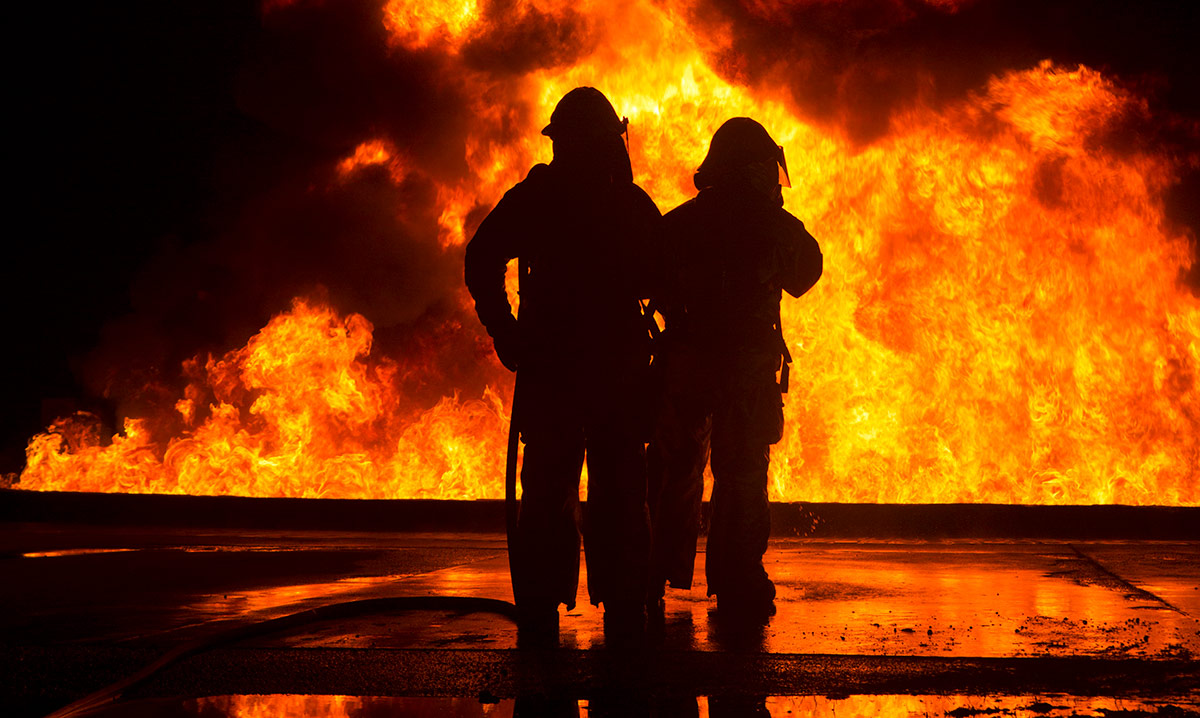When on active duty in the military, service members can become exposed to a variety of hazardous materials, environmental exposures, or airborne toxins, leading to long-term health consequences that may not be discovered until years later. Burn pits are especially concerning, as their open-air waste combustion methods could lead to the inhalation and toxic exposure of hazardous materials.
10 Conditions Caused by Burn Pit Exposure
- Cancer
- Skin Problems
- Asthma
- Bronchitis
- Sleep Apnea
- Respiratory Problems
- Pulmonary Conditions
- Cardiovascular Problems
- Migraines
- Neurological Conditions
The United States Department of Veterans Affairs (VA) provides veterans with benefits to cover their healthcare costs when they have a condition related to their time in military service. Burn pit exposure is one condition that veterans may receive disability compensation benefits for.
The VA is currently trying to determine some of the long-term health consequences associated with an open-air burn pit by allowing veterans to register for a burn pit registry to detail any side effects they believe stem from pit exposure. Although many side effects are believed to be temporary, experts believe that others could become more of a long-term health condition.
What Are Burn Pits?
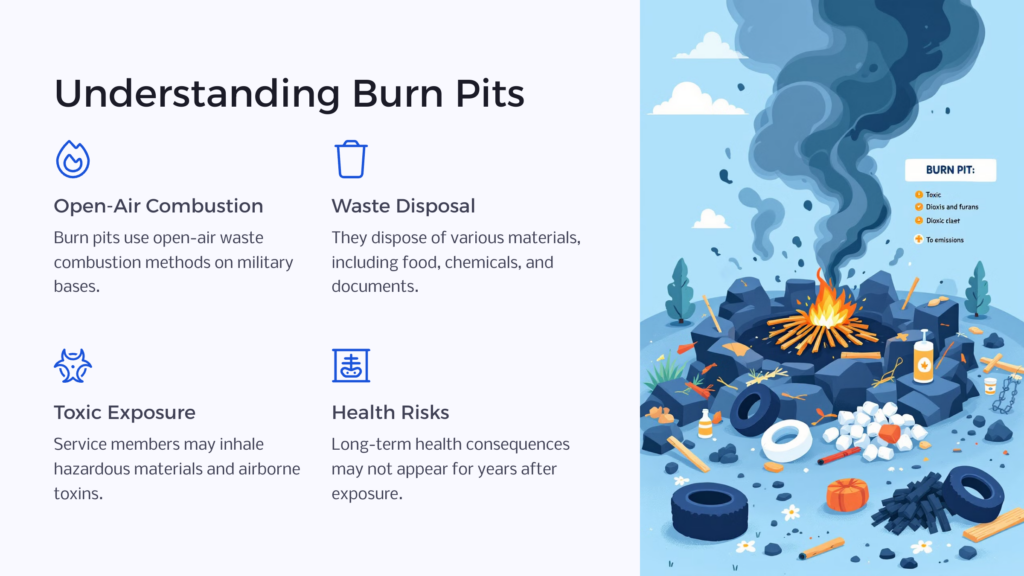
Known also as an open-air burn pit or open burn pit, burn pits are used by the military in areas of deployment, namely Iraq and Afghanistan, and the Gulf War. Although many burn pits are no longer used, some are still around, but often only in emergencies.
A military burn pit gets rid of waste and confidential documents and materials that the military doesn’t want to fall into enemy hands. For security reasons, the burn pit is located on a military base. Burn pits are quite large and put out an incredible amount of toxic smoke when materials are burned with jet fuel. Soldiers have no choice but to breathe in the toxins from the waste disposal.
Some of the items and substances destroyed in burn pits include, but aren’t limited to:
- Food waste
- Human waste and feces
- Plastic waste
- Papers and documents
- Electronics
- Chemicals
- Weapon materials
- Wood
- Rubber
- Petroleum products
Burn pits were thought of as necessities on military bases to quickly and efficiently get rid of waste and confidential materials. However, since determining that they pose not just an environmental airborne hazard but also potentially serious long-term health concerns, the military mostly uses other forms of waste disposal, including incinerators and landfills.
10 Conditions Caused by Burn Pit Exposure
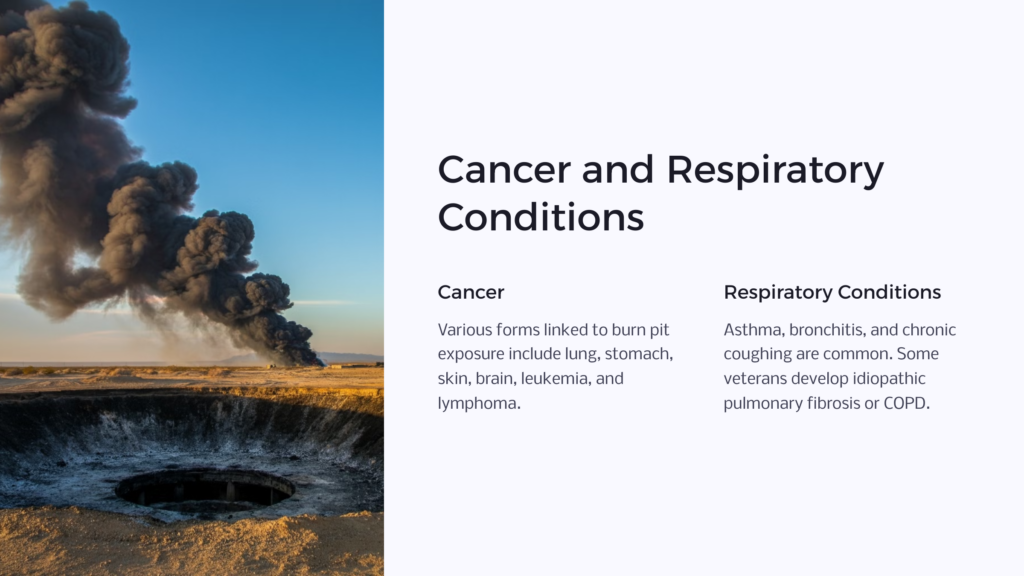
The VA is still investigating the possible long-term health effects of toxic exposure due to burn pits. However, from data already collected, several conditions have been linked to burn pit emissions, including those listed below.
Cancer
Like Agent Orange exposure, exposure to burn pit smoke and particulate matter may cause various forms of cancer. Lung, stomach, and skin cancers are some of the more common types, but brain cancer, leukemia, and lymphoma have also been reported. Prostate cancer, testicular cancer, blood cancer, and soft tissue sarcoma are also listed as service-connected cancers in the VA’s burn pit registry, according to a Burn Pits 360 study (PDF).
Skin Problems
Many of the skin conditions that active duty service members suffered as a result of exposure to burn pits were temporary, including rashes and severe itching. In most cases, the irritation subsided when the service member was no longer exposed to the toxic substances. However, others have experienced more long-term health effects, such as chronic skin rashes or skin cancers.
Asthma
Asthma is one of the most common potential side effects of pit smoke, as reported in the burn pit registry. Studies also show that service members who already suffered from asthma and other preexisting conditions may have been more at risk for cancers, respiratory illness, and cardiovascular symptoms after exposure to burn pits.
Bronchitis
Another common respiratory condition that may affect those exposed to pit emissions is bronchitis, an inflammation of the bronchial tubes’ lining. This chronic condition can last for weeks at a time and recur frequently. Some service members and veterans report suffering from constrictive bronchiolitis, a similar condition that causes the narrowing of the bronchus, making it difficult to breathe.
Sleep Apnea
Sleep apnea causes disruptive breathing patterns while you sleep, making it both a sleeping disorder and a respiratory condition that can have severe health consequences. While the connection of burn pits to sleep apnea continues to be studied, the condition is one of the more common conditions noted in the burn pit registry.
Respiratory Problems
Respiratory issues are commonly reported from veterans and service members who have been exposed to the airborne hazard of a burn pit. In addition to asthma, bronchitis, and sleep apnea, some veterans and service members suffer from chronic coughing, breathing difficulties, and throat discomfort.
Pulmonary Conditions
Lung disease is a common health condition noted by veterans and service members participating in the burn pit registry. One specific type of lung disease registry participants claim is idiopathic pulmonary fibrosis, a rare condition that creates problematic scar tissue within the lungs. The condition can sometimes be slowed down or made less severe with treatment, but it currently has no cure.
Chronic obstructive pulmonary disease (COPD) may also be linked to burn pit exposure. The condition causes excess mucus production, wheezing, and breathing problems.
Cardiovascular Problems
Some research has shown a potential correlation between burn pit exposure and cardiovascular symptoms, or those that affect the heart and its processes. Burn pits also have possible ties to sleep apnea, which may lead to cardiovascular problems in those with the condition. Sleep apnea sufferers may be up to four times as likely to experience heart arrhythmias.
Migraines
Migraines are intense headaches that often come with other symptoms, like nausea, sensitivity to light and sound, and confusion. Research has shown that some service members with no previous migraine history have exhibited migraine symptoms after exposure to burn pits, although the long-term side effects related to migraines remain unknown.
Neurological Conditions
The New York State Division of Veterans’ Services notes several symptoms and conditions believed to be caused by military base burn pits. Some of these conditions include stroke, Parkinson’s Disease, and peripheral neuropathy, which are all neurological conditions, or ones that affect the brain and nerves.
What Is the Burn Pit Registry?
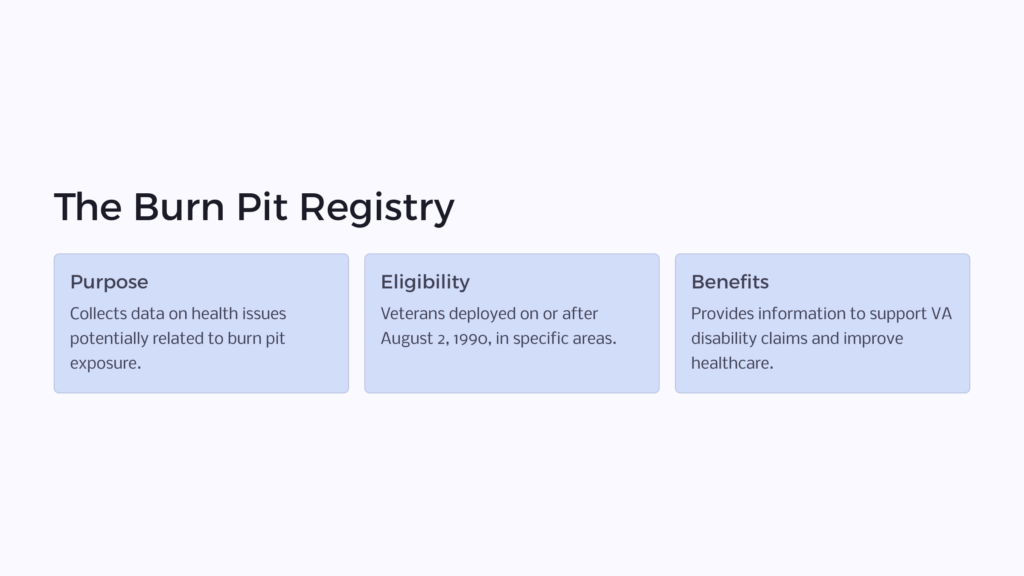
As the VA continues to understand the potential health implications of exposure to burn pits, it encourages service members and veterans to sign up for the Airborne Hazards and Open Burn Pit Registry, also known as the Burn Pit Registry. The registry allows veterans to document any symptoms or health conditions that they believe could be related to their exposure to burn pits.
The primary goal of the burn pit registry is to have collective information about respiratory illness, lung disease, cancer, pulmonary symptoms and conditions, and other health issues that could be relevant to burn pits. The VA uses this information to improve awareness of the potential long-term health effects of burn pit exposure and improve VA health care and other programs that help veterans affected by burn pits.
Although participation in the burn pit registry is voluntary, it does come with its benefits. One significant benefit is that the information you provide to the pit registry through the optional health evaluation can also come in handy if you’re applying for disability benefits with the VA. This health information is one piece of data that you can use to support your VA disability claim.
To be eligible to participate in the burn pit registry, you must have deployed on or after August 2, 1990, or on or after September 11, 2001, in specific areas where burn pits were used. These include Saudi Arabia, Kuwait, Iraq, Afghanistan, the Gulf of Oman, and Qatar. Visit the Airborne Hazards and Open Burn Pit Registry to sign up. You’ll need a Premium DS Logon Level 2 account to start the process.
VA Disability Benefits for Burn Pit Exposure
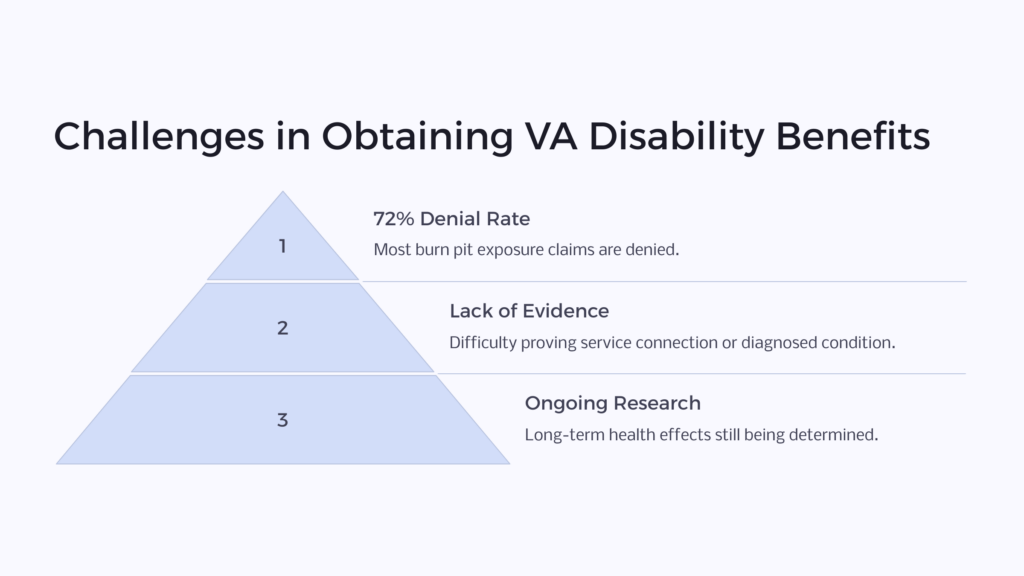
Because the effects of burn pit exposure are still being determined through research, studies, and the open burn pit registry, there’s not enough solid information to link specific conditions to burn pits. Unfortunately, the lack of evidence has caused the VA to deny 72% of burn pit exposure claims for VA benefits. Most commonly, a VA disability claim for burn pit exposure gets denied due to an inability to prove a service connection or the veteran not having a medically diagnosed condition.
However, lawmakers are working to protect veterans who have been exposed to burn pits. Two senators have recently reintroduced a measure known as the Presumptive Benefits for War Fighters Exposed to Burn Pits and Other Toxins Act into Congress. The measure would make it easier for eligible veterans to qualify for VA disability benefits and disability compensation without needing to show as much proof that their conditions or symptoms were caused by burn pits.
If the bill becomes law, eligible veterans who served during the Global War on Terror or the Gulf War can become approved if they suffer from an eligible condition. Some of the qualifying conditions include respiratory cancer, brain cancer, pulmonary fibrosis, emphysema, and chronic bronchitis.
If you believe you’re entitled to a burn pit claim to VA disability benefits due to exposure to the toxic fumes of burn pits, you might consider contacting a VA disability attorney to help you prove your service connection and get you the benefits you deserve. The current process for applying for VA benefits for burn pit exposure is complicated, so it could help to have a knowledgeable advocate on your side.
A Conditional Update
In August 2021, the VA made a change to a list of approved presumptive conditions related to airborne hazards and burn pit exposure.
Three new presumptive conditions have been added: Sinusitis, Rhinitis, and Asthma. To qualify for disability benefits, the conditions must have appeared within 10 years of the veteran’s separation date.
The update only applies to Veterans who:
- Served in the Southwest Asia theater of operations from August 2, 1990, to the present
- Served in Syria, Djibouti, Afghanistan, and Uzbekistan during the Persian Gulf War, from September 19, 2001, to the present
Fortunately, veterans don’t have to file any new claims to be awarded benefits. The VA will automatically contact each eligible veteran after their claim has been reevaluated.
Burn Pits and the Open Burn Pit Registry
Exposure to toxic burn pits could be one of the most hazardous issues many veterans have had to face. When it comes to getting VA benefits related to burn pit exposure, the process is often lengthy and challenging, as proof of exposure during the veteran’s service is difficult to prove. For this reason, many VA claims for benefits from burn pits are denied.
The VA is working toward getting veterans the benefits to which they should be entitled by offering the Airborne Hazards and Open Burn Pit Registry. The burn pit registry allows veterans to document their symptoms and conditions, giving the VA more information to work with when collecting data about the long-term health consequences of burn pits.
With this information in hand and the work veteran advocates and legislators are doing to make sure exposed veterans get benefits, the future is looking a little brighter for those who’ve worked alongside open burn pits. If you’d like to apply for benefits now, consider speaking with a VA disability attorney or a veterans service officer (VSO) to get more information about applying for benefits and what to expect from the claims process.
If you have a claim you’d like to file, your first stop should be our free assessment to see if you qualify for even more benefits.
 Benefits.com Advisors
Benefits.com Advisors
With expertise spanning local, state, and federal benefit programs, our team is dedicated to guiding individuals towards the perfect program tailored to their unique circumstances.
Rise to the top with Peak Benefits!
Join our Peak Benefits Newsletter for the latest news, resources, and offers on all things government benefits.















